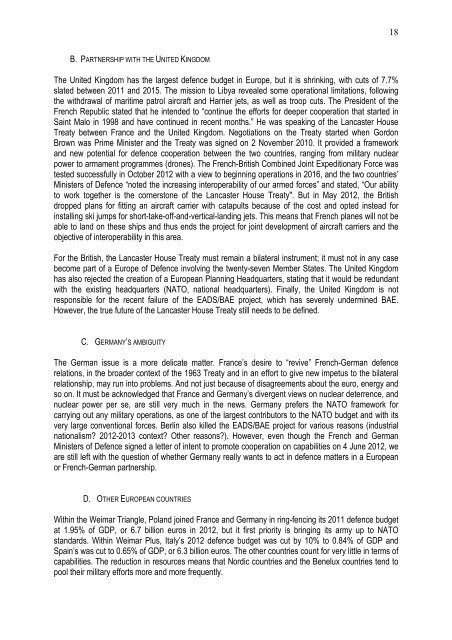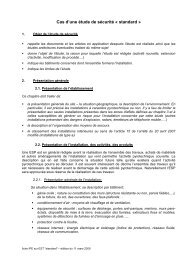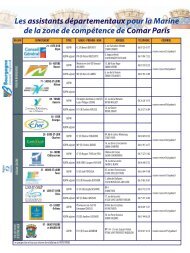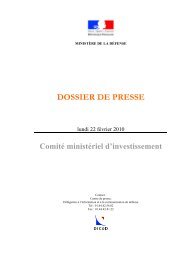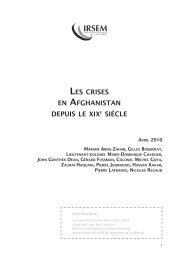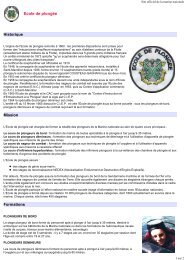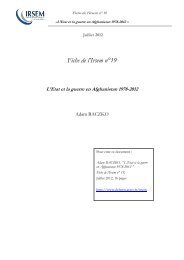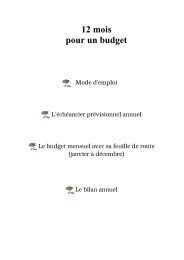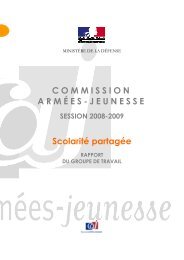Rapport Védrine_ENG_GERMAN - Ministère de la Défense
Rapport Védrine_ENG_GERMAN - Ministère de la Défense
Rapport Védrine_ENG_GERMAN - Ministère de la Défense
Sie wollen auch ein ePaper? Erhöhen Sie die Reichweite Ihrer Titel.
YUMPU macht aus Druck-PDFs automatisch weboptimierte ePaper, die Google liebt.
B. PARTNERSHIP WITH THE UNITED KINGDOM<br />
The United Kingdom has the <strong>la</strong>rgest <strong>de</strong>fence budget in Europe, but it is shrinking, with cuts of 7.7%<br />
s<strong>la</strong>ted between 2011 and 2015. The mission to Libya revealed some operational limitations, following<br />
the withdrawal of maritime patrol aircraft and Harrier jets, as well as troop cuts. The Presi<strong>de</strong>nt of the<br />
French Republic stated that he inten<strong>de</strong>d to “continue the efforts for <strong>de</strong>eper cooperation that started in<br />
Saint Malo in 1998 and have continued in recent months.” He was speaking of the Lancaster House<br />
Treaty between France and the United Kingdom. Negotiations on the Treaty started when Gordon<br />
Brown was Prime Minister and the Treaty was signed on 2 November 2010. It provi<strong>de</strong>d a framework<br />
and new potential for <strong>de</strong>fence cooperation between the two countries, ranging from military nuclear<br />
power to armament programmes (drones). The French-British Combined Joint Expeditionary Force was<br />
tested successfully in October 2012 with a view to beginning operations in 2016, and the two countries’<br />
Ministers of Defence “noted the increasing interoperability of our armed forces” and stated, “Our ability<br />
to work together is the cornerstone of the Lancaster House Treaty". But in May 2012, the British<br />
dropped p<strong>la</strong>ns for fitting an aircraft carrier with catapults because of the cost and opted instead for<br />
installing ski jumps for short-take-off-and-vertical-<strong>la</strong>nding jets. This means that French p<strong>la</strong>nes will not be<br />
able to <strong>la</strong>nd on these ships and thus ends the project for joint <strong>de</strong>velopment of aircraft carriers and the<br />
objective of interoperability in this area.<br />
For the British, the Lancaster House Treaty must remain a bi<strong>la</strong>teral instrument; it must not in any case<br />
become part of a Europe of Defence involving the twenty-seven Member States. The United Kingdom<br />
has also rejected the creation of a European P<strong>la</strong>nning Headquarters, stating that it would be redundant<br />
with the existing headquarters (NATO, national headquarters). Finally, the United Kingdom is not<br />
responsible for the recent failure of the EADS/BAE project, which has severely un<strong>de</strong>rmined BAE.<br />
However, the true future of the Lancaster House Treaty still needs to be <strong>de</strong>fined.<br />
C. <strong>GERMAN</strong>Y’S AMBIGUITY<br />
The German issue is a more <strong>de</strong>licate matter. France’s <strong>de</strong>sire to “revive” French-German <strong>de</strong>fence<br />
re<strong>la</strong>tions, in the broa<strong>de</strong>r context of the 1963 Treaty and in an effort to give new impetus to the bi<strong>la</strong>teral<br />
re<strong>la</strong>tionship, may run into problems. And not just because of disagreements about the euro, energy and<br />
so on. It must be acknowledged that France and Germany’s divergent views on nuclear <strong>de</strong>terrence, and<br />
nuclear power per se, are still very much in the news. Germany prefers the NATO framework for<br />
carrying out any military operations, as one of the <strong>la</strong>rgest contributors to the NATO budget and with its<br />
very <strong>la</strong>rge conventional forces. Berlin also killed the EADS/BAE project for various reasons (industrial<br />
nationalism? 2012-2013 context? Other reasons?). However, even though the French and German<br />
Ministers of Defence signed a letter of intent to promote cooperation on capabilities on 4 June 2012, we<br />
are still left with the question of whether Germany really wants to act in <strong>de</strong>fence matters in a European<br />
or French-German partnership.<br />
D. OTHER EUROPEAN COUNTRIES<br />
Within the Weimar Triangle, Po<strong>la</strong>nd joined France and Germany in ring-fencing its 2011 <strong>de</strong>fence budget<br />
at 1.95% of GDP, or 6.7 billion euros in 2012, but it first priority is bringing its army up to NATO<br />
standards. Within Weimar Plus, Italy’s 2012 <strong>de</strong>fence budget was cut by 10% to 0.84% of GDP and<br />
Spain’s was cut to 0.65% of GDP, or 6.3 billion euros. The other countries count for very little in terms of<br />
capabilities. The reduction in resources means that Nordic countries and the Benelux countries tend to<br />
pool their military efforts more and more frequently.<br />
18


